Recently, the original diagnosis and treatment results of electrocardiology jointly completed by Professor Yan Yang's team from Cardiovascular Disease Hospital of the First Affiliated Hospital of Xi’an Jiaotong University (XJTU), Department of Gastroenterology and single-cell sequencing platform were published inJAMA Internal Medicine(impact factor=21.87). The First Affiliated Hospital of XJTU is the first and corresponding affiliation. Professor Yan Yang from Department of Cardiovascular Surgery is the corresponding author.
Article I: Typical Electrocardiogram Pattern Unmasks Atypical Cause of Muscle Weakness
On August 9, 2021, the original diagnosis and treatment results of electrocardiogram (ECG) of Cardiovascular Disease Hospital of our hospital entitled “Typical Electrocardiogram Pattern Unmasks Atypical Cause of Muscle Weakness” were online published in the form of "Challenges in Clinical Electrocardiography" of "Clinical Review & Education" column ofJAMA Internal Medicine, which illustrated the significant value of application of clues provided by 12-lead body surface ECG in guiding the treatment of severe muscle weakness.
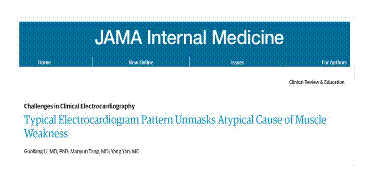
【Summary of research results】
The patient was admitted to the Emergency Department due to severe muscle weakness in the lower limbs. Although the patient was administered with long-term potassium chloride tablets to mitigate hypokalemia-associated muscle weakness caused by anorexia nervosa, the physicians performed 12-leadECGbefore implementing emergency empirical potassium supplementation to alleviate the lower-limb muscle weakness.ECGdetected the sign of sinus rhythm, and symmetrical hyper T waves in V2-V6 and I-II leads. These changes were consistent with the ECG findings of hyperkalemia, suggesting that muscle weakness may be caused by hyperkalemia rather than hypokalemia, which is a more frequent cause.
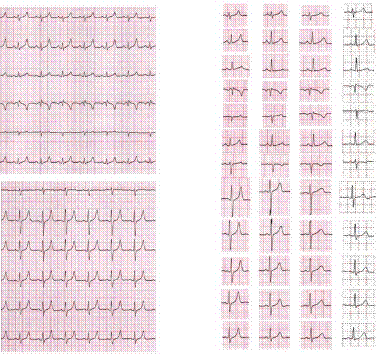
Figure: Dynamic evolution of ECG in a patient with severe muscle weakness
Blood gas analysis was simultaneously performed in Emergency Department and ICU ofDepartment of Cardiovascular Surgeryof our hospital, prompting the diagnosis of hyperkalemia. After repeatedly inquiring the medical history, the patient had a history of taking excessive-dose potassium chloride. Therefore, it was considered that muscle weakness was caused by hyperkalemia rather than hypokalemia. Emergent potassium-lowering therapy was delivered. After corresponding treatment, serum potassium level was gradually decreased to normal range. ECG reexamination showed that hyper T waves in corresponding leads were gradually restored to normal. At the presence of hyperkalemia, the formation and conduction of action potential were blocked and the membrane excitability was reduced, eventually leading to muscle weakness. In this study, the patient had a history of anorexia nervosa, and intermittent hypokalemia caused recurrent muscle weakness in the lower limbs. Potassium supplementation could alleviate these symptoms. Hence, it was likely to consider that the lower-limb weakness is also caused by hypokalemia. However, ECG upon admission indicated the diagnosis of hyperkalemia, mainly manifested as "tent-like" T waves with hyper, symmetric and narrow base on the precordial leads.
Based on the research results, the authors proposed the following diagnosis and treatment highlights:
1. Hyperkalemia is not a common cause of muscle weakness.
2. Hyper T-wave appears in the precordial leads (V2-V4), indicating hyperkalemia.
3. The diagnosis of hyperkalemia should be considered for patients who are hospitalized due to muscle weakness symptoms and evident ECG abnormality.
PhD Li Guoliang, Attending Physician from Department of Cardiovascular Medicine and single-cell sequencing platform, and Tang Manyun, a professional postgraduate student of 2019, are the co-first authors.
Article II: Abnormal Electrocardiograms After Diarrhea and Syncope in the Emergency Department
On October 4, 2021, another series of original diagnosis and treatment results of ECG of Cardiovascular Disease Hospital were published online in the form of "Challenges in Clinical Electrocardiography" of "Clinical Review & Education" column ofJAMA Internal Medicine. The article was entitled "Abnormal Electrocardiograms After Diarrhea and Syncope in the Emergency Department", illustrating how to utilize the clues provided by body surface ECG to diagnose and rapidly and effectively treat syncope patients in Emergency Department, and deliver in-depth analysis of the bioelectrical activities of myocardial cells and tissues, body surface ECG characteristics in hypokalemia patients, and unravel their relationship.
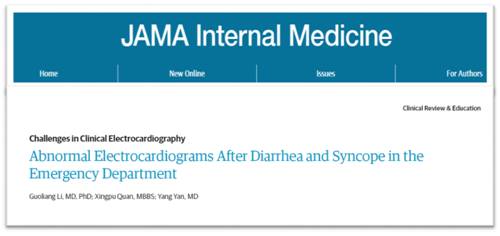
【Summary of research results】
A elderly male patient was admitted because of syncope. He had a history of severe vomiting and diarrhea prior to syncope. ECG upon admission showed the sign of ventricular extrasystole, especially in I and V1 leads. Serum potassium and magnesium levels were 2.63 mmol/L and 0.97 mmol/L. Considering that hypokalemia, QT prolongation and subsequent R-on-T phenomenon are common predictors of Torsadesde Pointes (TdP), it is highly suspected that TdP is associated with syncope. When the precursor of syncope recurred after the patient was admitted, spontaneous termination of TdP recorded by real-time ECG confirmed this speculation.
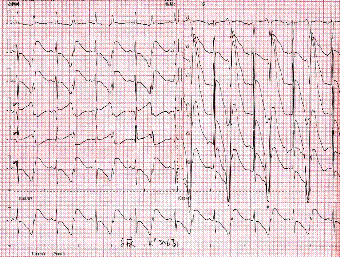
Figure: Abnormal electrocardiogram of the diarrhea patient after syncope in Emergency Department
Potassium and magnesium supplementation (intravenous potassium-magnesium polarization solution and oral potassium-magnesium aspartate tablets) were delivered to mitigate electrolyte disorder. Subsequently, ventricular premature beat was gradually reduced and eventually cured along with the recovery of serum potassium level to normal range. The patient was discharged, and neither syncope precursor nor syncope symptom occurred during 3-month follow-up.
In excitable tissues, such as heart, serum potassium level is strictly regulated to stabilize myocardial cells. In normal heart tissues, repolarization dysfunction of a single component of does not necessarily lead to significant prolongation of action potential duration and secondary arrhythmia at the cellular level. However, under certain circumstances, one or more ion currents may cause functional disorder due to the abnormalities of congenital or acquired factors, which can increase the transmural dispersion of repolarization and elevate the risk of malignant arrhythmia. In addition, active supplementation of magnesium ions in patients with hypokalemia (intravenous potassium-magnesium polarization solution and oral potassium-magnesium aspartate tablets in this study) will contribute to mitigating intracellular hypokalemia and relieving calcium overload, thereby more effectively treating hypokalemia and lowering the risk of malignant arrhythmia.
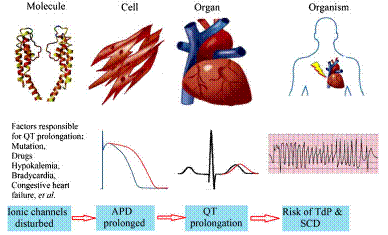
Figure: One or more ion currents may cause functional disorder due to the abnormalities of congenital or acquired factors, which can increase the transmural dispersion of repolarization and elevate the risk of TdP & SCD
Based on these research results, the authors put forward the following diagnosis and treatment highlights:
1. Abnormal ECG caused by hypokalemia is highly common in patients presenting with vomiting and diarrhea, and the phenotypic variation is large.
2. The possibility of TdP should be considered for patients with vomiting, diarrhea and syncope, especially those with R-on-T and QTc prolongation indicated by ECG.
3. Basic QT prolongation may increase the risk of TdP in hypokalemia individuals.